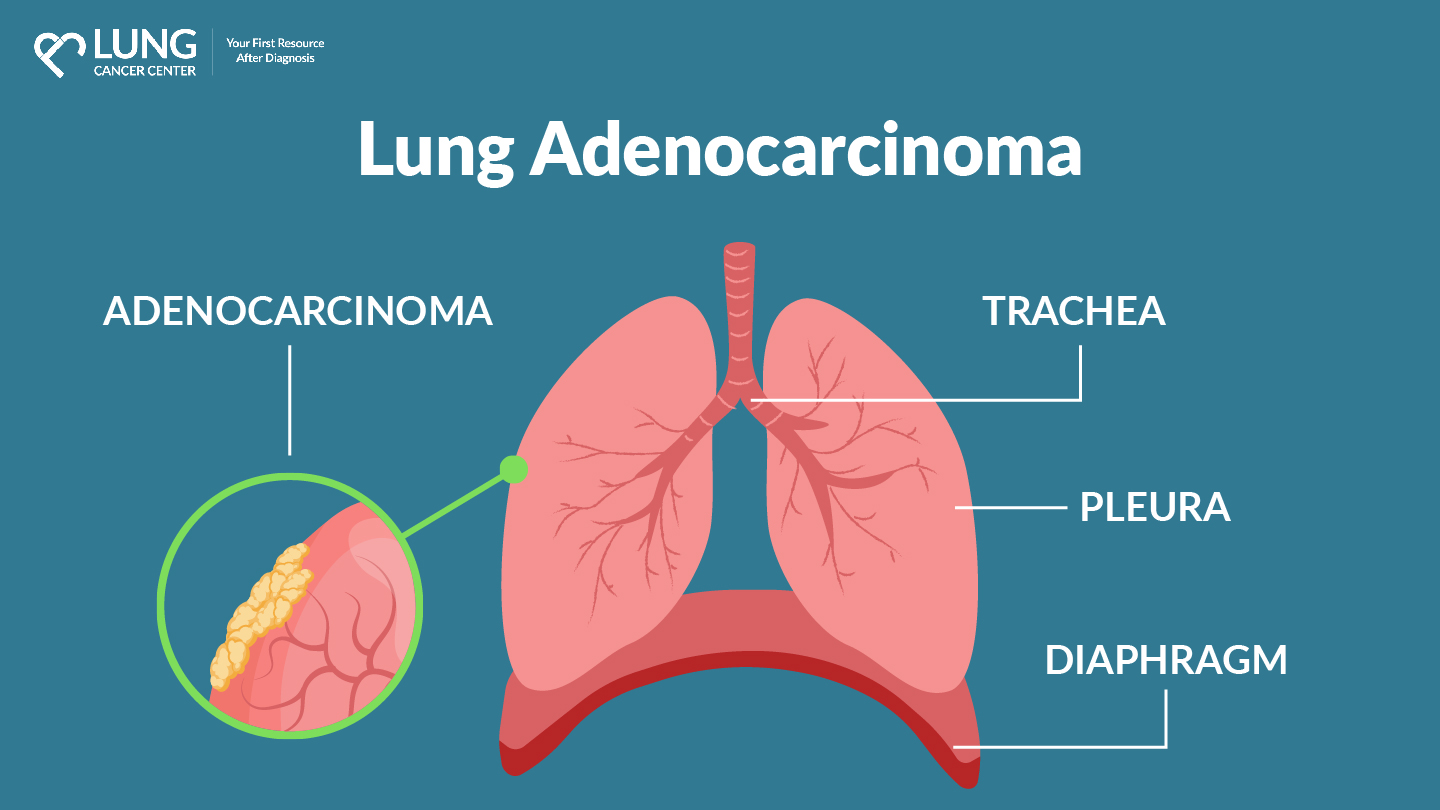Adenocarcinoma of the Lung
Adenocarcinomas are a subtype of cancer that develop in mucous-producing glands. These types of tumors develop primarily in the lungs, but can also form in the stomach, esophagus, and other organs in the body.


What Is Adenocarcinoma?
Cancers are classified by where they form in the body, and each type can be further divided into smaller subtypes based on specific cell characteristics. One of these subtypes is adenocarcinoma, which develops in the mucus-secreting glands found in various tissues and organs. When tumors form in these glands, they are classified as adenocarcinomas. Lung adenocarcinoma is the most common type, accounting for about 40 percent of all lung cancers.
For those diagnosed with lung adenocarcinoma, factors like the stage of cancer, lifestyle, and exposure history all play a role in determining the best approach to care. If you’ve worked in high-risk environments or been exposed to hazardous materials like asbestos, it’s important to seek regular screenings to catch any potential issues early. In this article we will explore it’s connection to asbestos and what you can do to seek treatment and support.
Adenocarcinomas and Asbestos
Prolonged exposure to asbestos is a significant risk factor for developing lung adenocarcinoma. Asbestos, a naturally occurring mineral prized for its flame-resistant properties, was commonly used in construction materials and industrial products throughout much of the 20th century. It was incorporated into building insulation, roofing, and other materials, making it a staple in construction and manufacturing from the early 1900s.
However, the dangers of asbestos exposure became widely recognized in the late 20th century, leading to a ban on its use in the U.S. by the late 1970s. When asbestos fibers are disturbed, they can become airborne and easily inhaled or ingested. Once inside the body, these fibers can lodge in lung tissue or other areas, causing inflammation and scarring that, over time, can lead to serious conditions such as lung adenocarcinoma and mesothelioma. Even decades after exposure, these diseases can emerge, which is why individuals with past asbestos exposure should remain vigilant about their health and seek early medical screenings.

Occupations at Risk of Exposure to Asbestos
Certain professions, especially in construction, manufacturing, and industrial work, carry a higher risk of asbestos exposure due to the material’s widespread use for its heat-resistant properties. Workers who handled machinery, insulation, or heat-prone materials—such as mechanics, shipbuilders, and those in the U.S. military—were frequently exposed to asbestos, placing them at an elevated risk of developing asbestos-related diseases like lung adenocarcinoma and mesothelioma, which often appear years after initial exposure.
Other High Risk Occupations include:
- Boiler workers
- Drywallers
- Firefighters
- Mechanics
- Miners and mill workers
- Plumbers
- Roofers
- Sailors and ship workers
- Steel mill crews
These workers were often in direct contact with asbestos-containing materials, sometimes unknowingly, increasing their risk of developing serious respiratory diseases over time.
Adenocarcinoma Types
Adenocarcinomas are the most common subtype of several cancers due to the presence of mucus-producing glands in various organs. This type of cancer can develop in the stomach, esophagus, pancreas, and colon, among other areas. Although tumors typically originate in the glands, they can spread to nearby tissues and organs. In advanced cases, cancer can metastasize to distant areas, including the brain, making early detection and treatment an important crossroads to managing the disease.

Adenocarcinoma Symptoms
Adenocarcinoma symptoms vary depending on where tumors form in the body. In the lungs, it may present with bloody mucus, chronic coughing, hoarseness, and wheezing. Stomach adenocarcinoma often leads to a constant feeling of fullness, blood in the stool, heartburn, and recurring abdominal pain. When the esophagus is affected, symptoms can include chest pain, difficulty swallowing, persistent coughing, and a sore throat.
Across many forms of the disease, patients often experience general symptoms like unexplained weight loss and fatigue. If any of these signs persist, it’s important to seek medical attention for a proper diagnosis.

Diagnosing Lung Adenocarcinoma
Diagnosing lung adenocarcinoma involves several key steps. Initially, doctors may use imaging tests such as X-rays, MRIs, or CT scans to look for abnormal masses in the lungs. These tests serve as a preliminary measure when cancer is suspected and help determine the next steps for further evaluation. If needed, a doctor may perform a lab review by extracting fluid or mucus from affected areas for analysis. Ultimately, a biopsy is often necessary, where a surgeon removes a small tissue sample from the suspected tumor site for pathological examination. This comprehensive approach helps ensure an accurate diagnosis and informs the appropriate treatment plan.

Adenocarcinoma of the Lung Treatment and Therapy
After the medical diagnosis determines the type and stage of disease (how far it has progressed), the doctor will develop a coinciding treatment plan. If the stage is early enough, and tumors have not spread too far into the body, medical professionals can use one or multiple of the following treatments to remove tumors:
Sometimes if tumors have advanced too far, treatments may be used for palliative care or as pain and symptom management instead of curative. A patient can also change their diet and exercise routine to try and help improve their medical prognosis. Ask your doctor for specifics.
Lung Adenocarcinoma VS Mesothelioma
Lung adenocarcinoma and mesothelioma can be easily confused due to their similar symptoms and proximity in the lungs. However, a key distinction lies in their origins: mesothelioma tumors develop in the lining of the lungs, while lung adenocarcinoma arises from mucus-secreting glands located within the lung tissue itself. If you believe you’ve been misdiagnosed by a doctor, you’re entitled to a second opinion from a different medical professional.
Legal Options for Treatment Support
Since asbestos was determined to be a carcinogen (a cancer-causing substance) by authorities, its usage, production, and removal became heavily regulated. This was to protect workers from negligent exposure while at work.These regulations primarily focus on how asbestos is handled and removed from structures and materials and hold the owners of the asbestos companies responsible for proper removal of the toxin.
If you receive an adenocarcinoma of the lung (or other asbestos-related diseases) diagnosis and believe it’s due to exposure in the workplace, you could file a claim against the companies responsible and receive financial compensation. To explore your legal options and receive personalized guidance, visit our case evaluation page and contact a patient advocate today.


